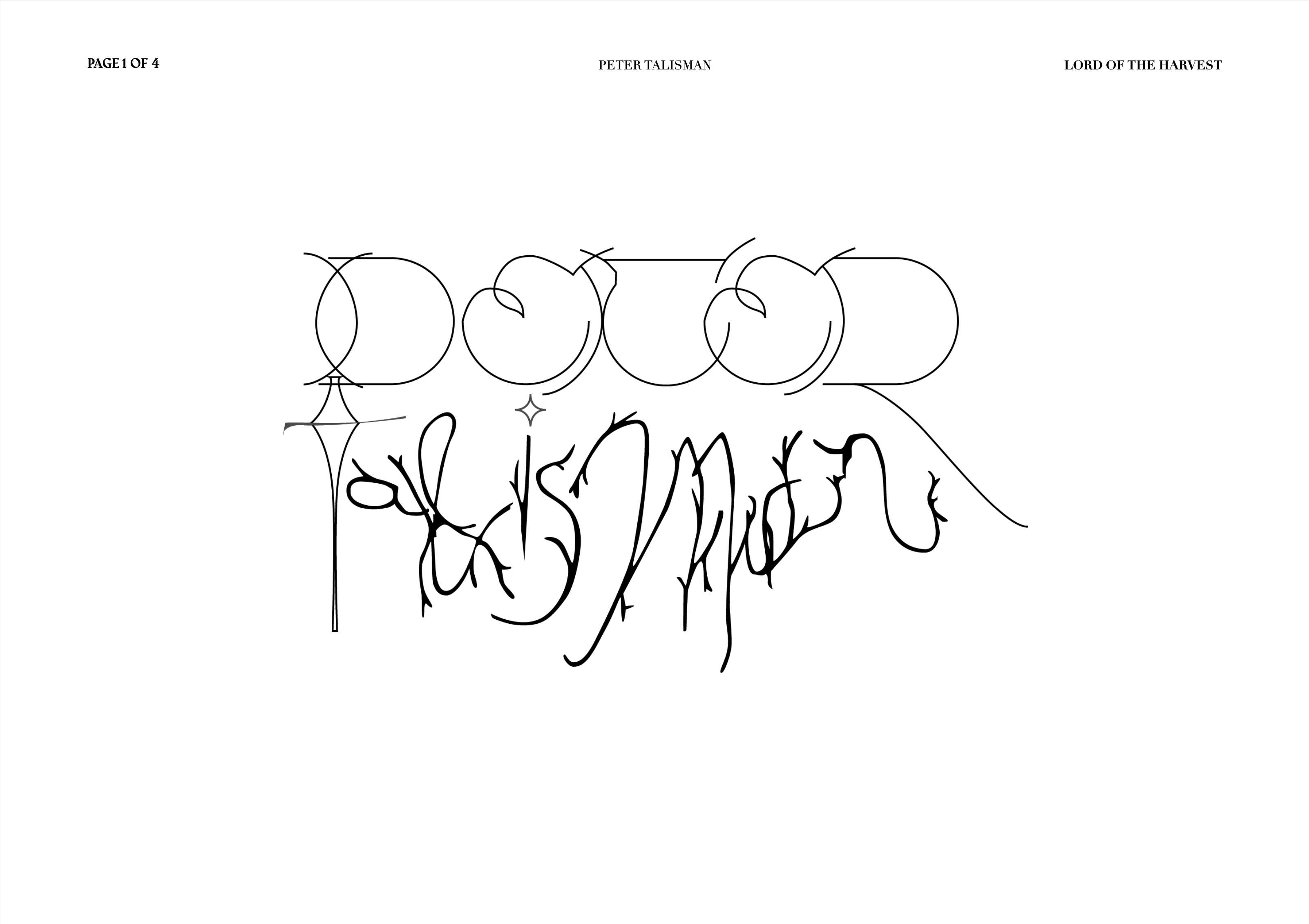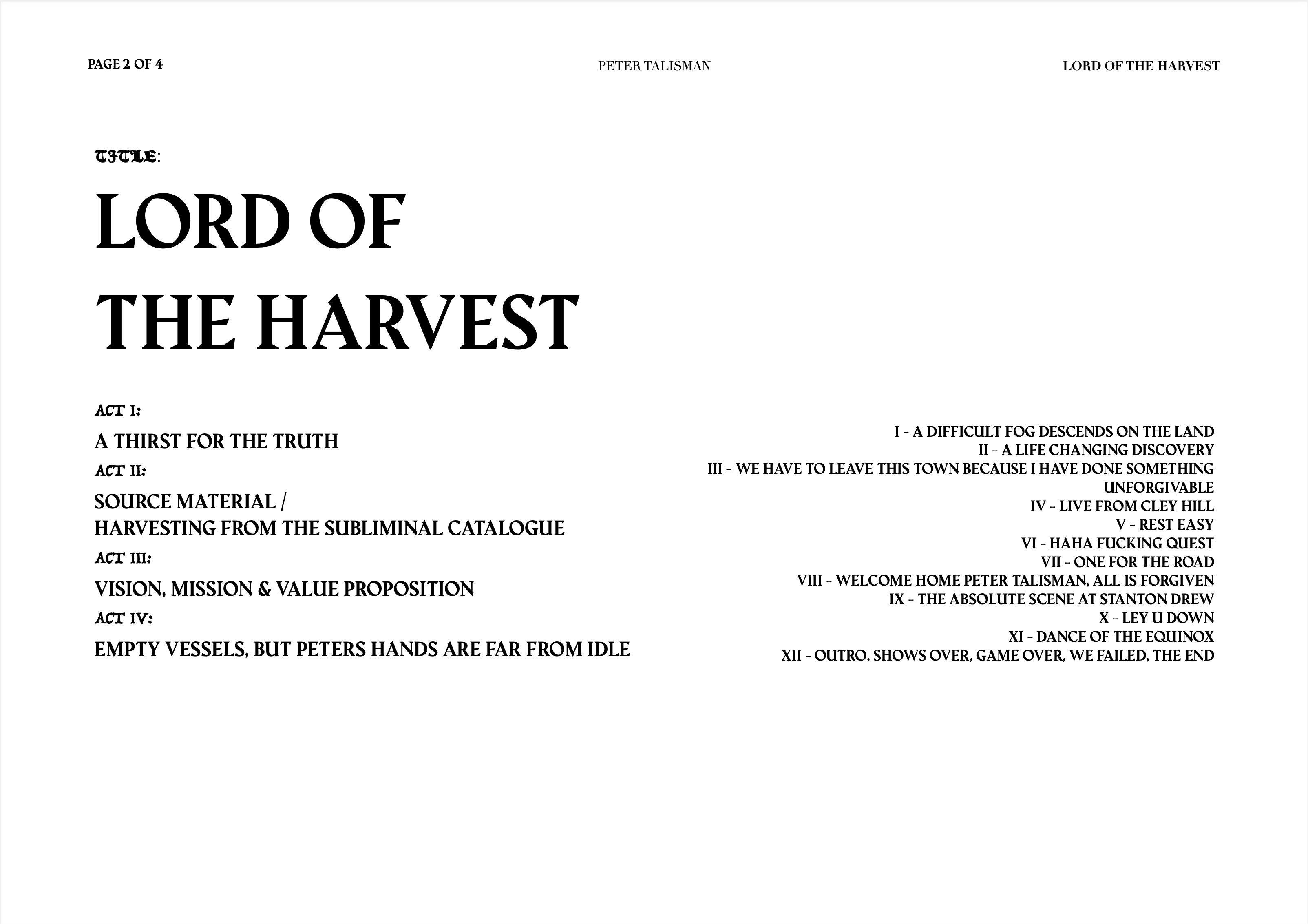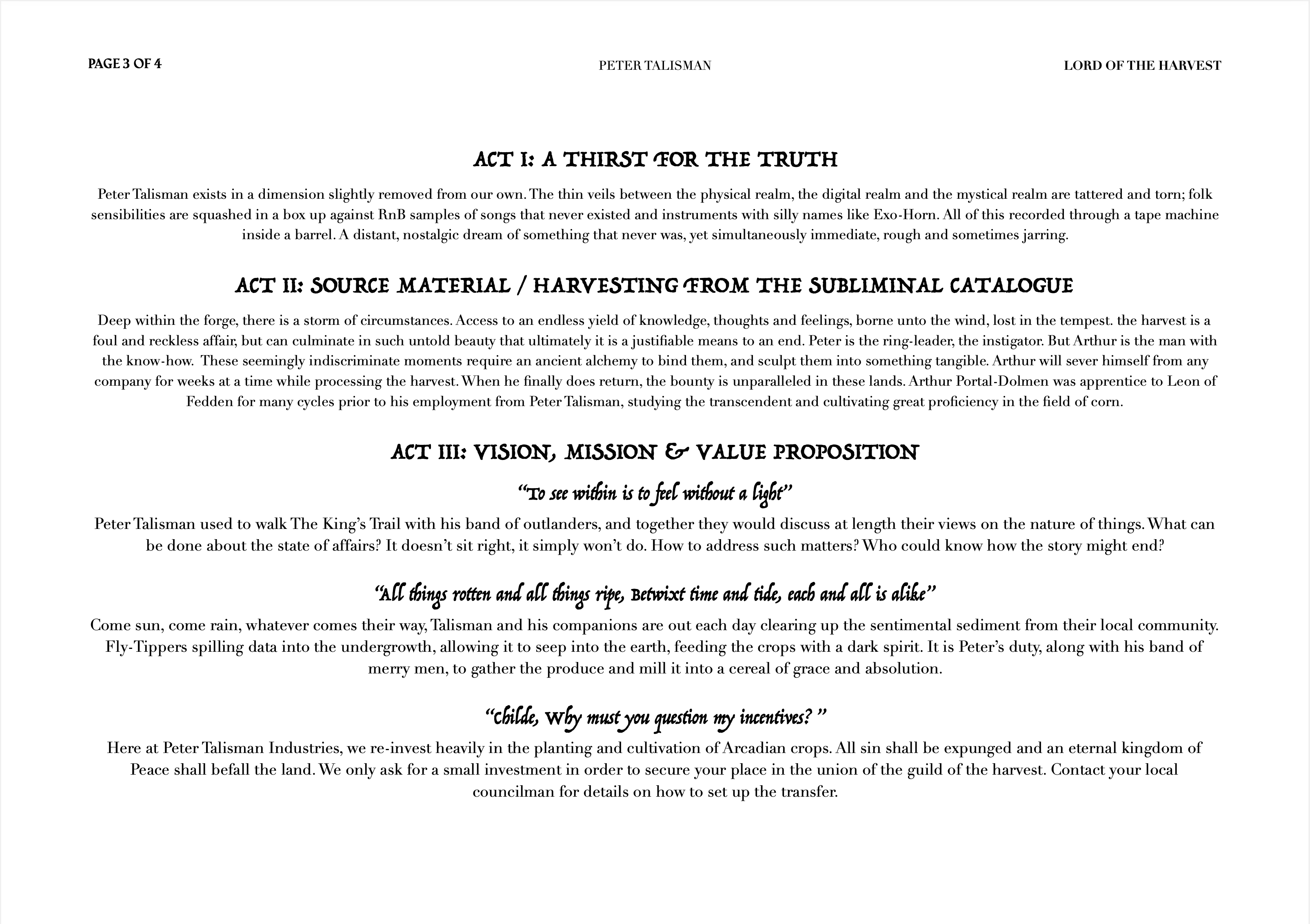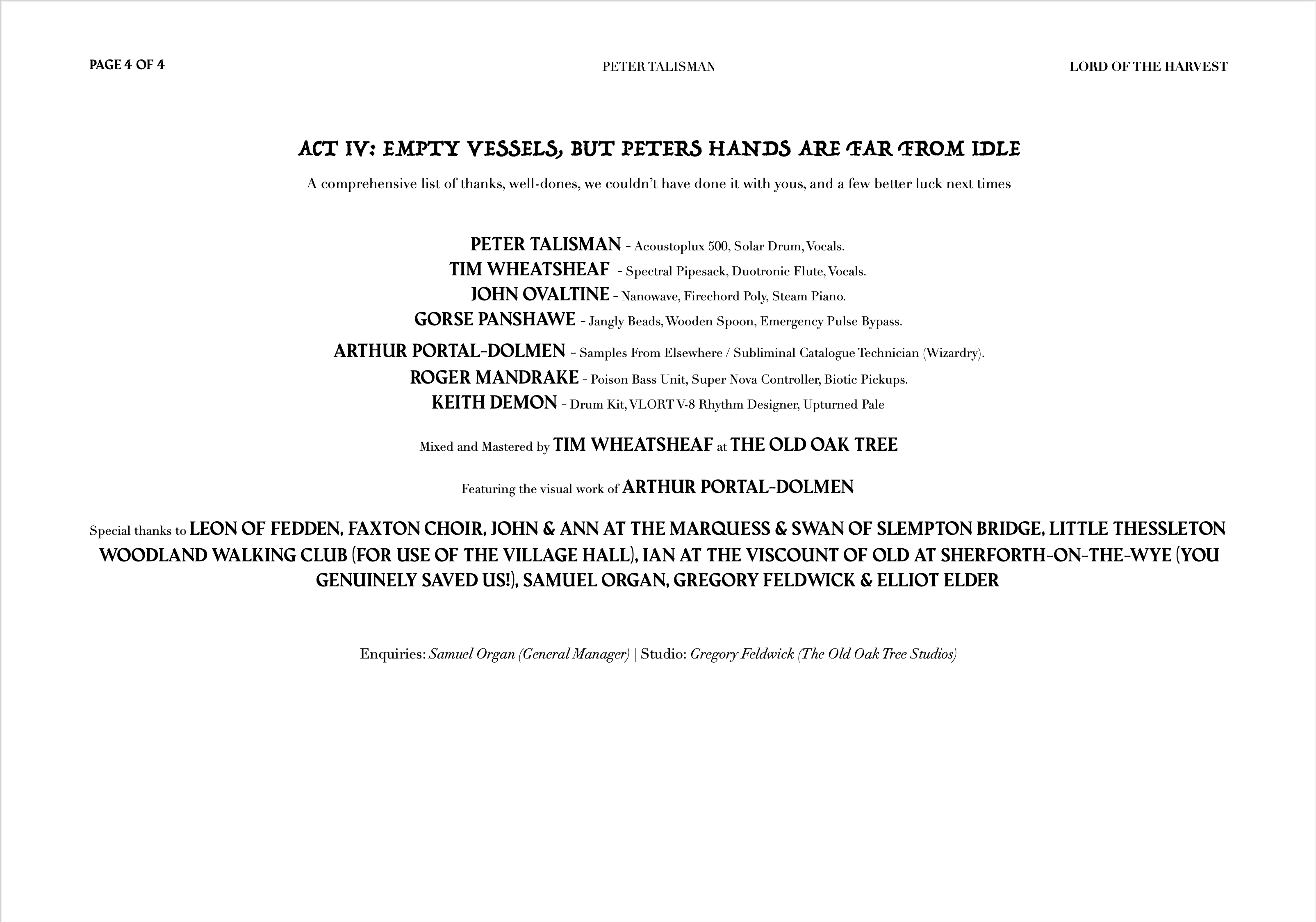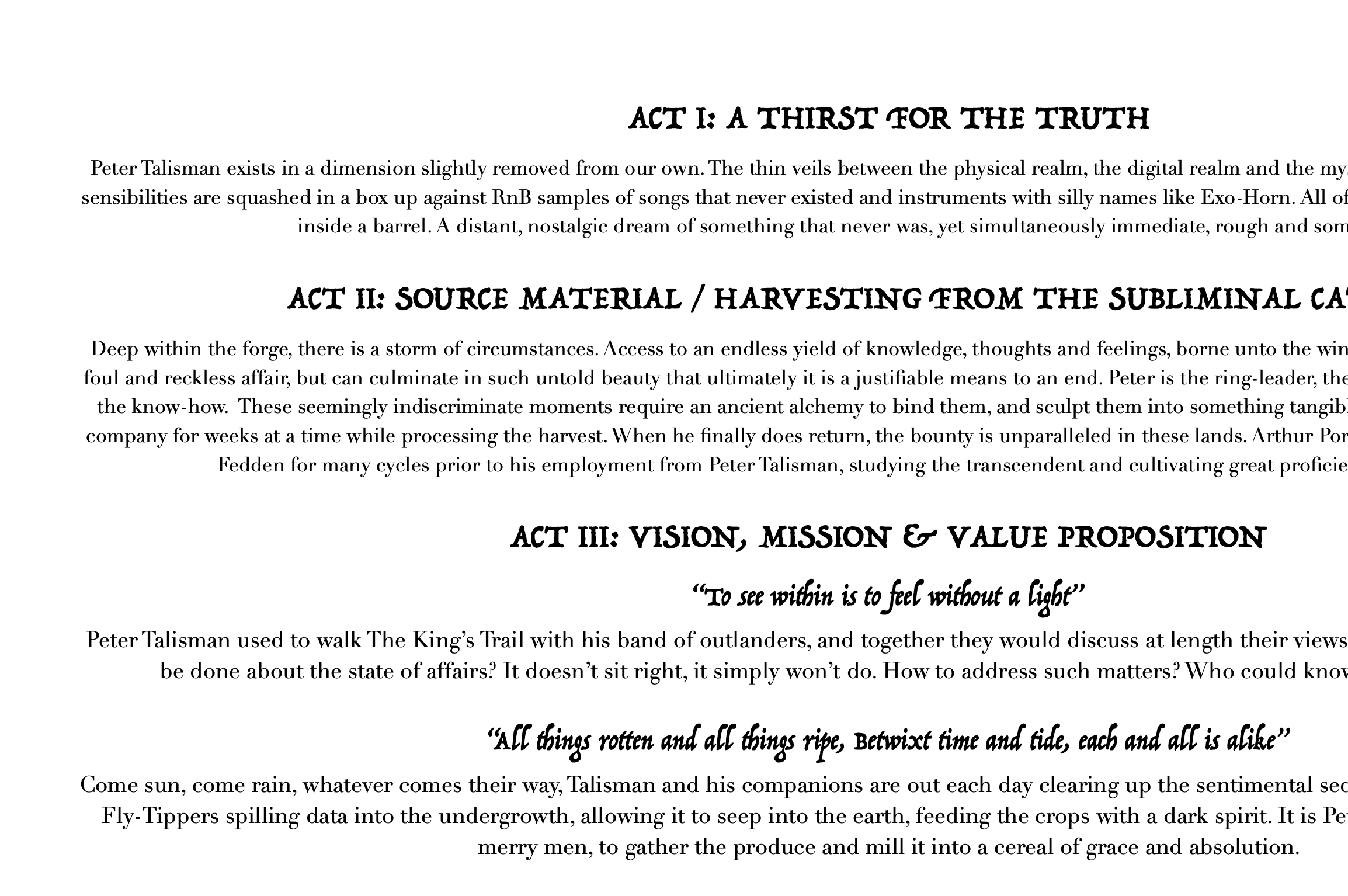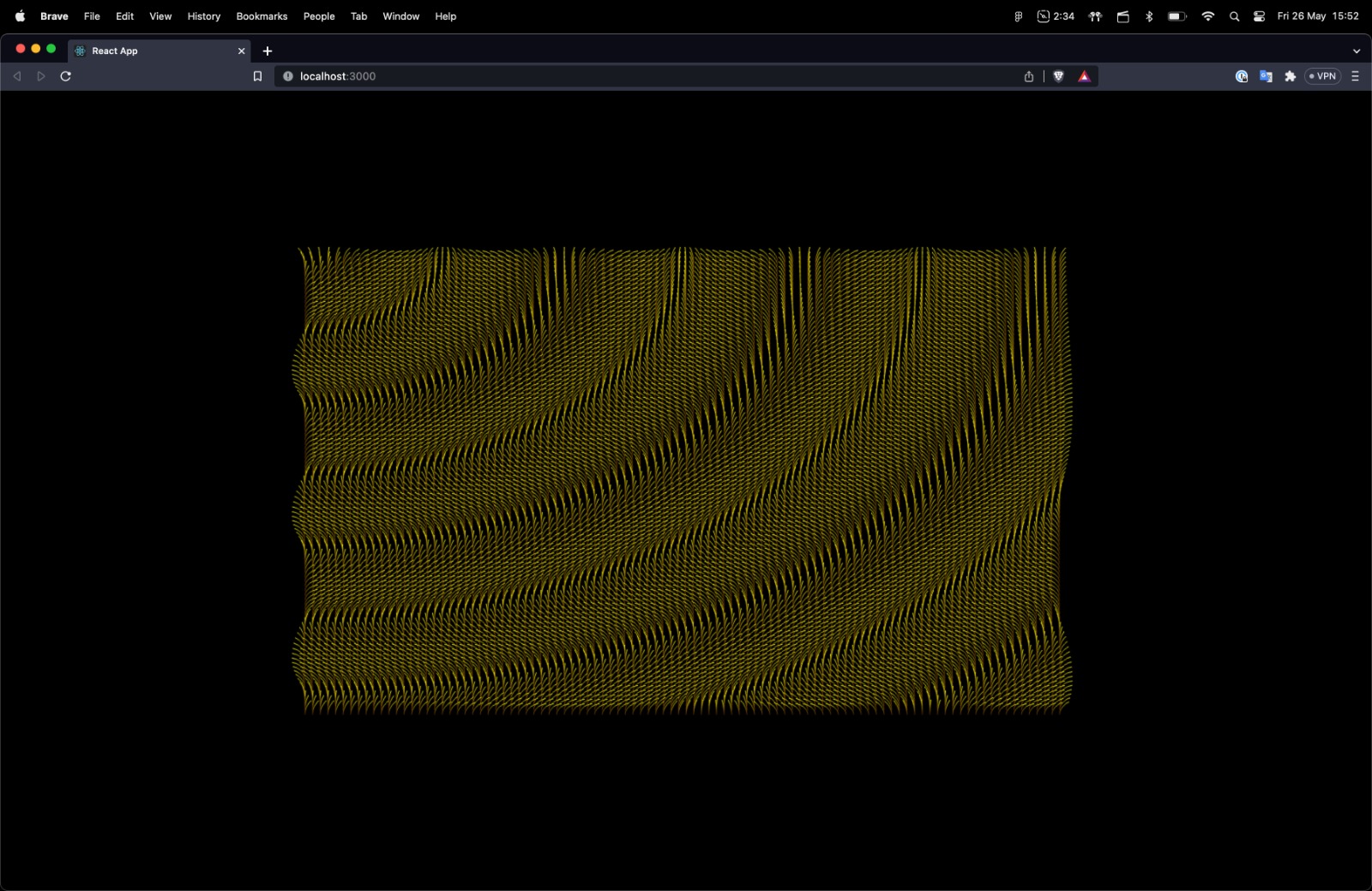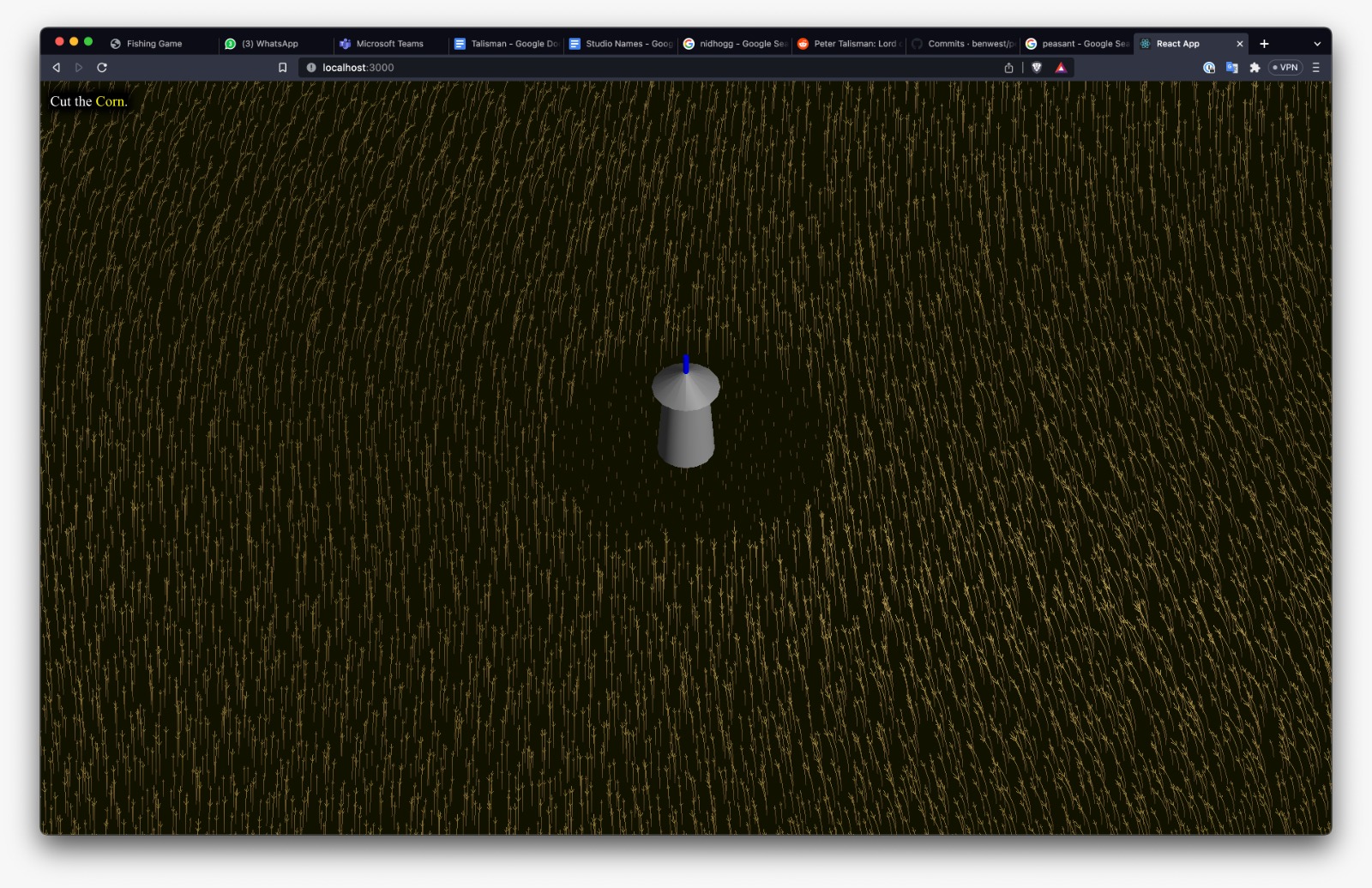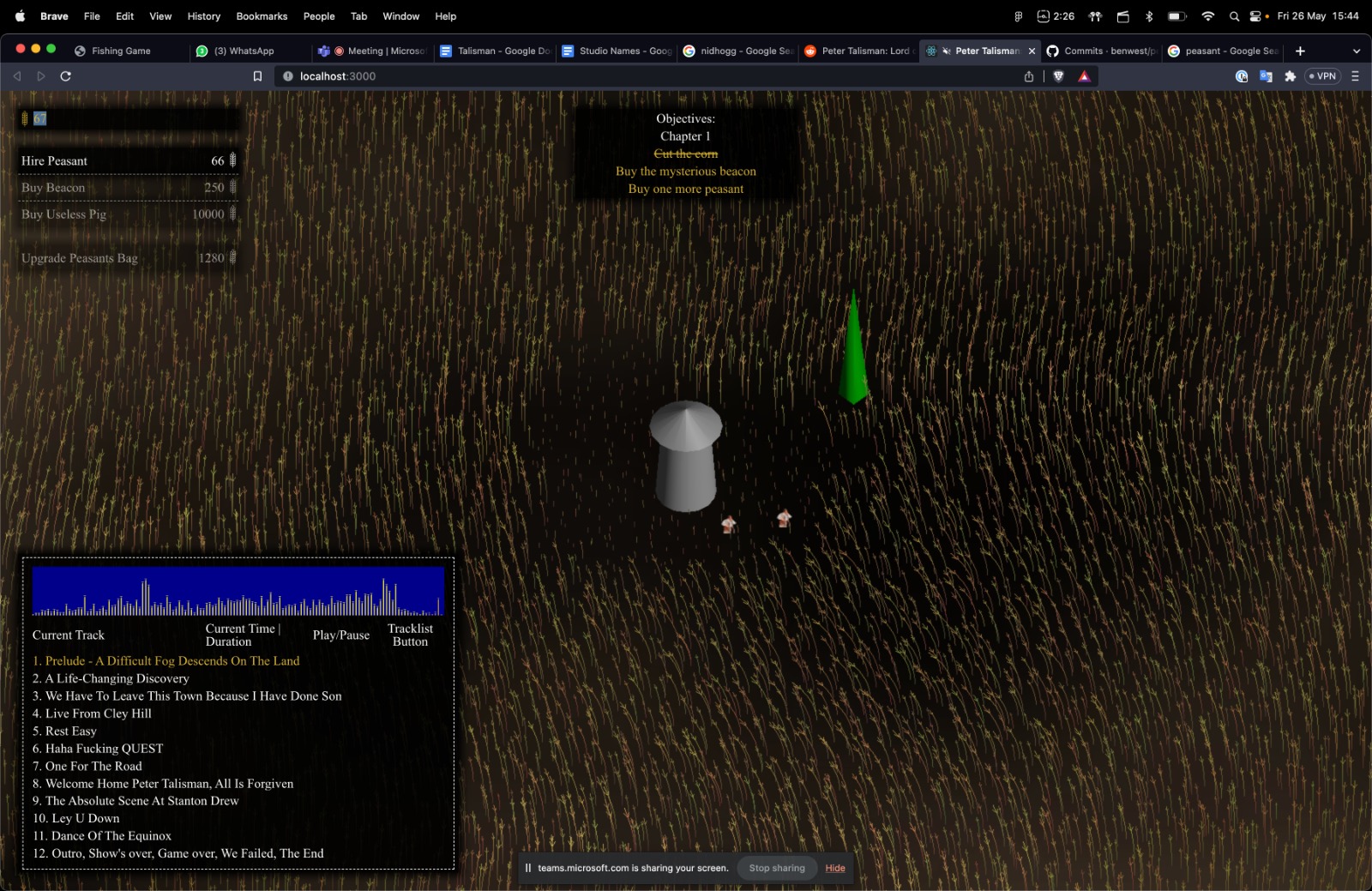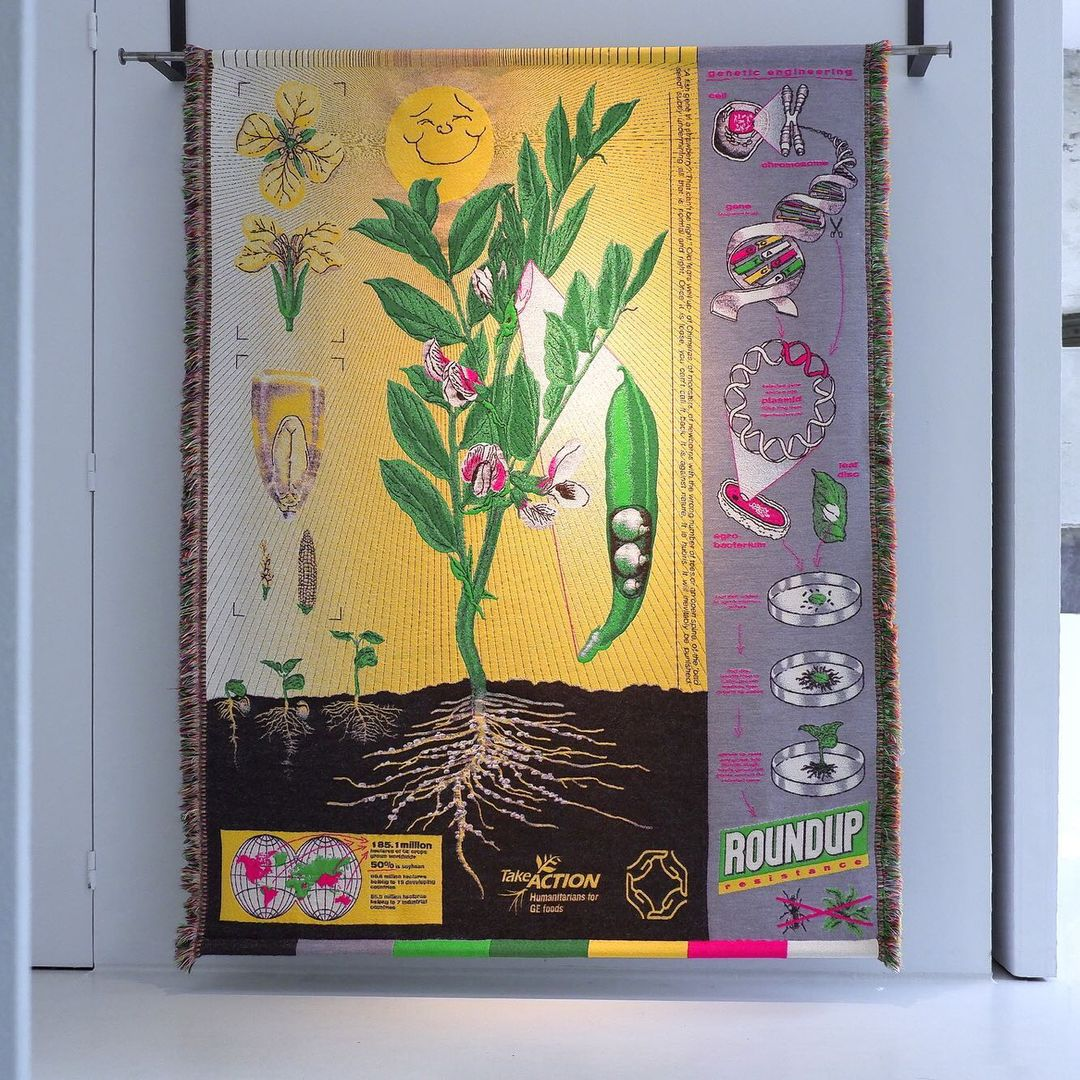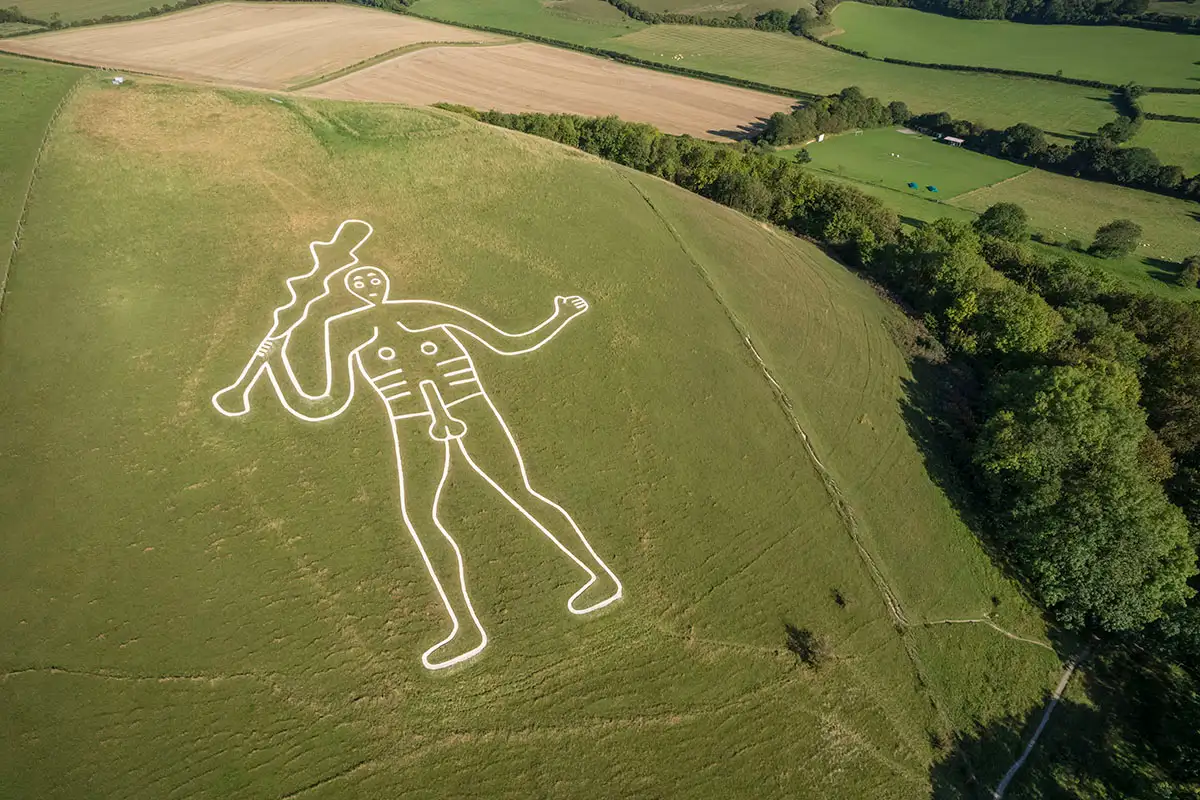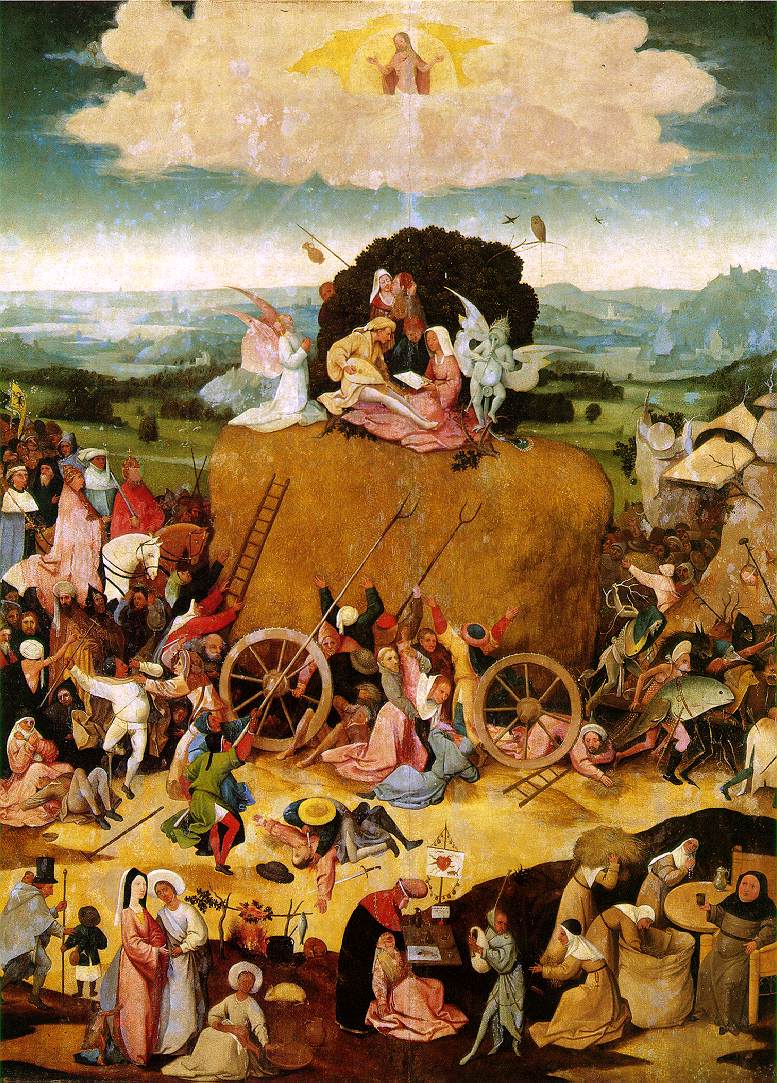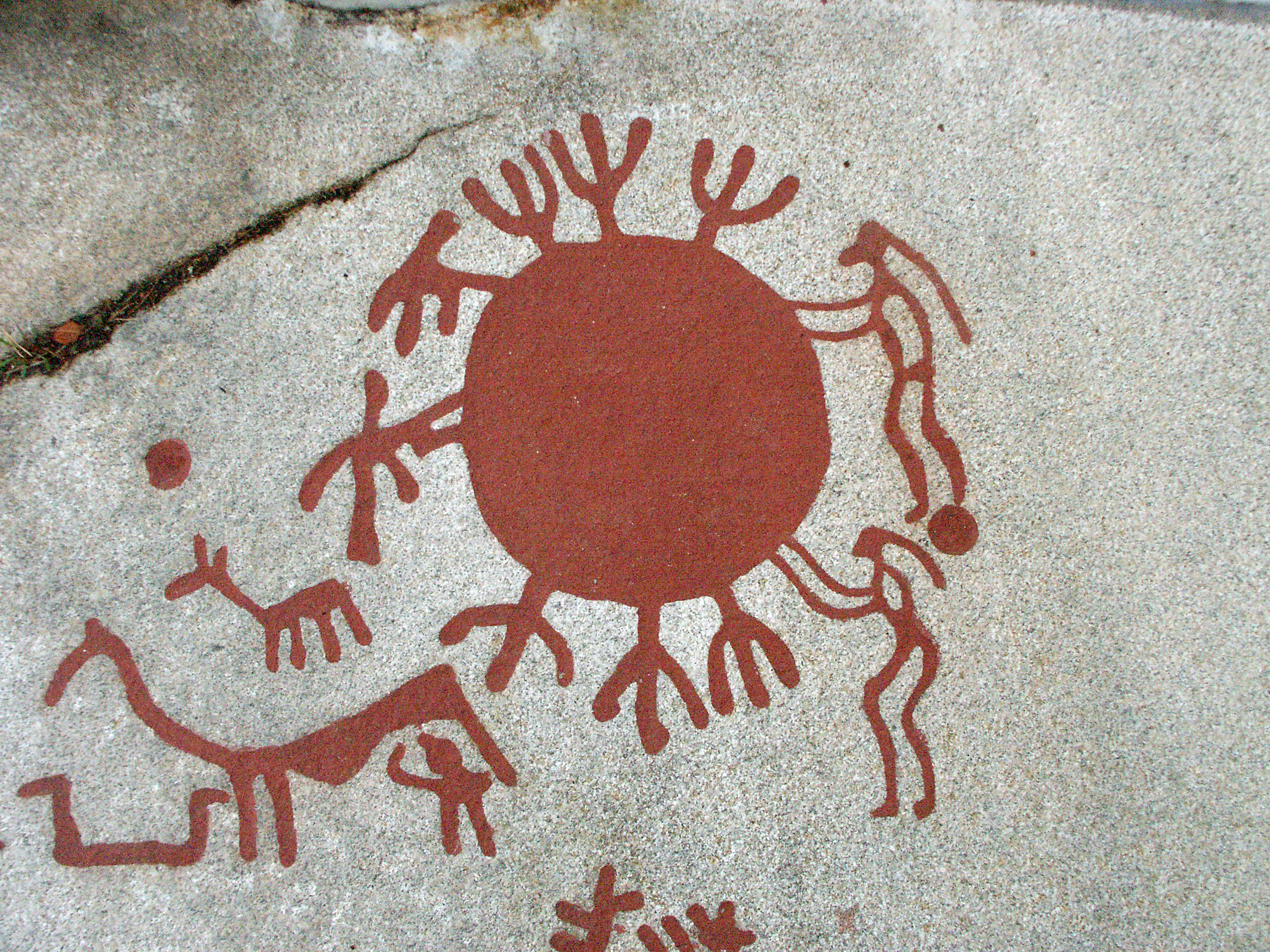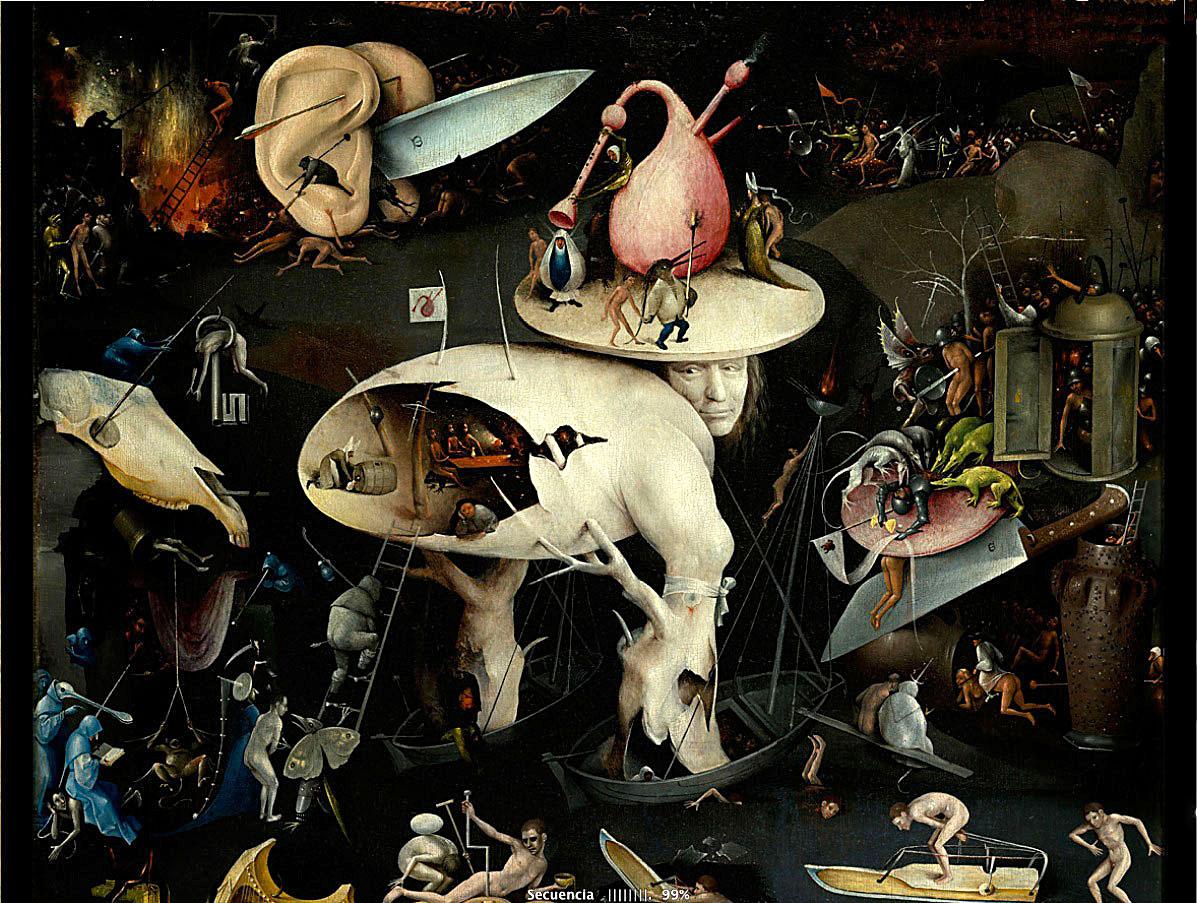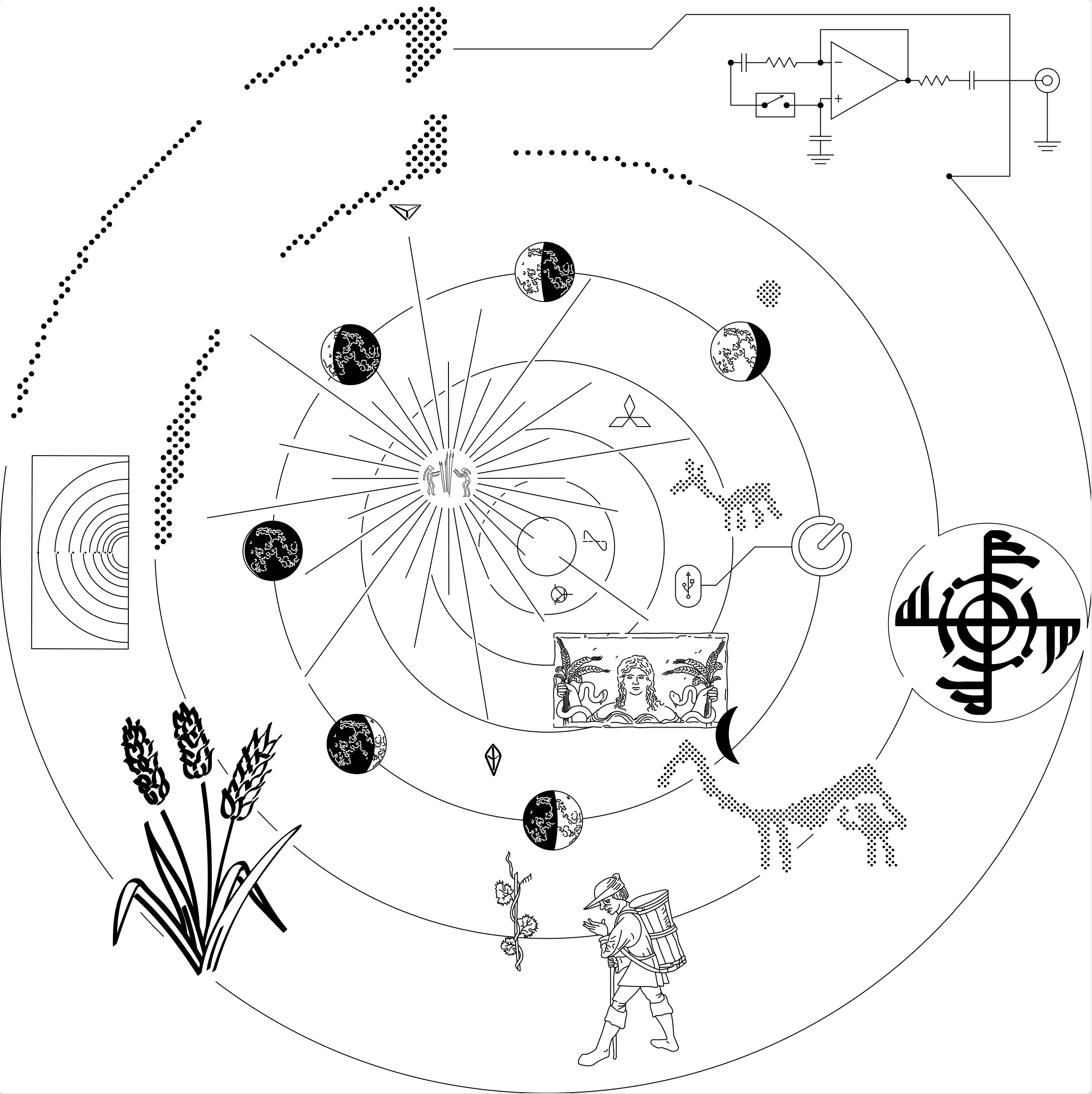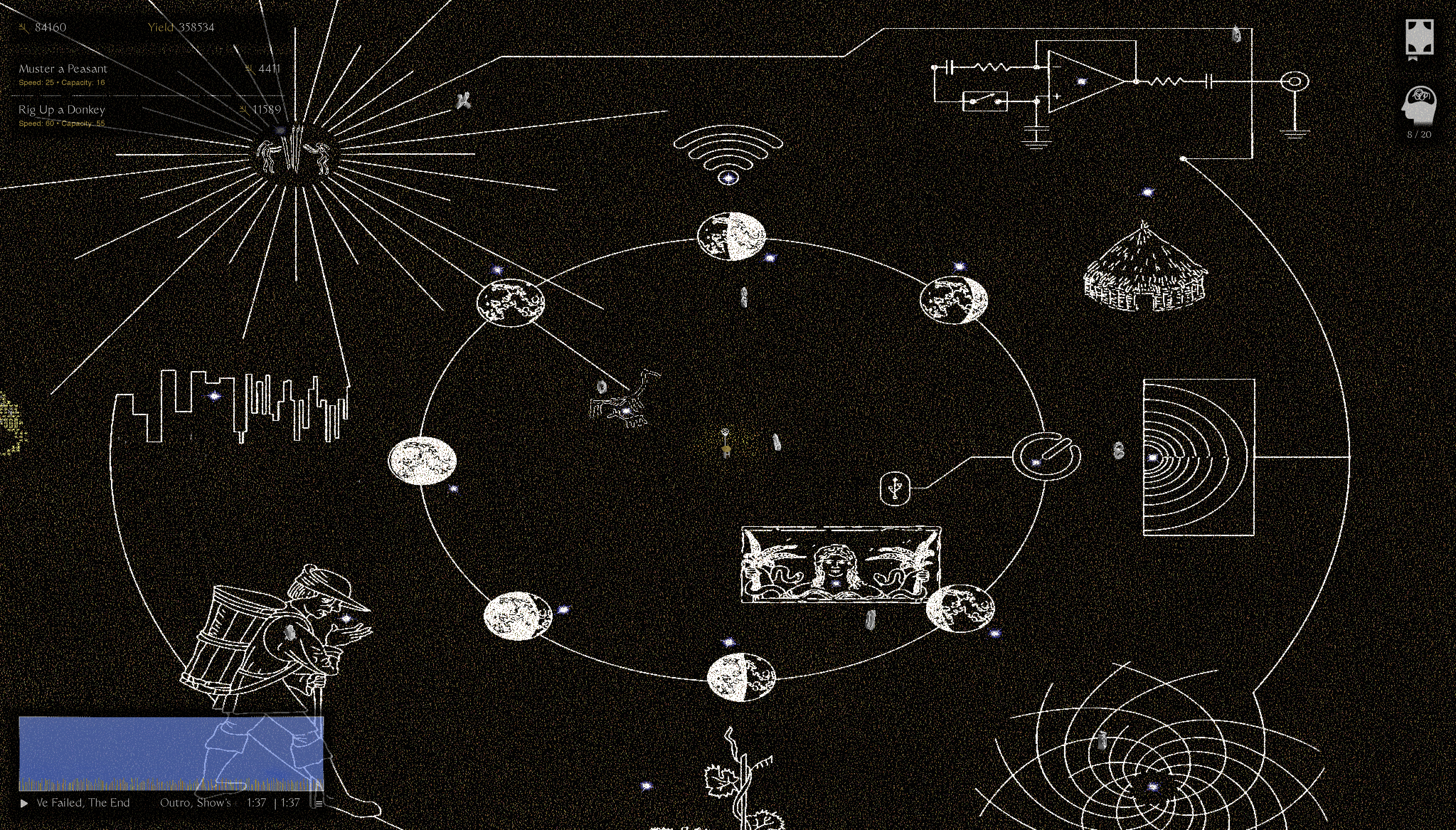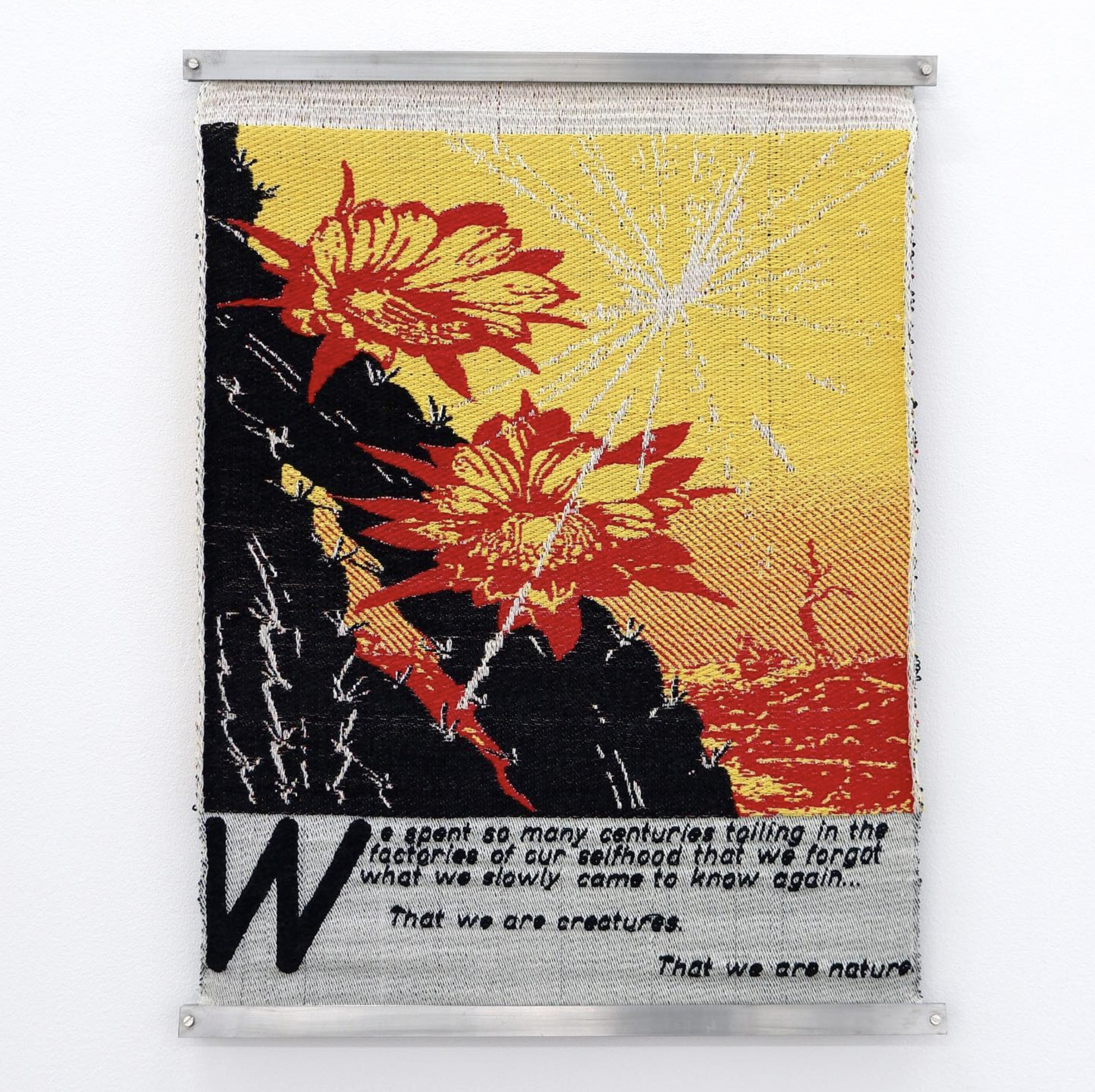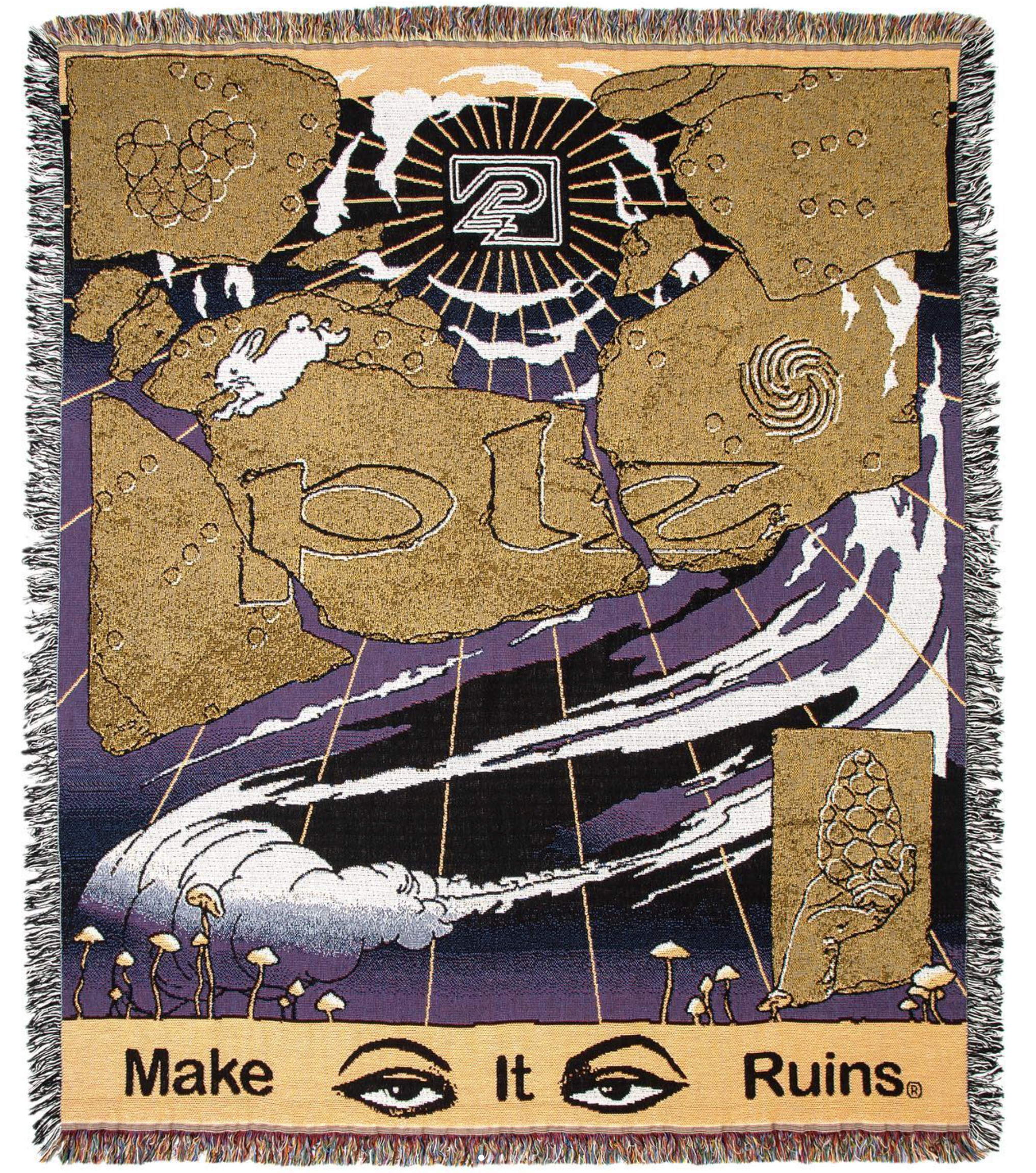How a request to promote an album turned into a web-based interactive experience that started a game development studio, we speak to Soft Earth about creating Peter Talisman
At Kepler we see games as an integral part of the fabric of culture in the same way we see fashion, film, art and music. We’re curious about these fields and how games have influenced their processes and ideas, and we know that the people who make games are inspired by other fields in return. This is the first example of our new editorial direction, where we share stories about creativity that have influenced, or are influenced by, games. This first iteration is a conversation with nascent studio Soft Earth and Kepler’s creative director, Simon Sweeney.
Soft Earth consists of Ben West, Joseph Pleass and Callum Copley. A game development studio that coalesced around the creation of petertalisman.quest, a web-based interactive experience made to promote the release of experimental folk electronic album Lord of the Harvest from musical duo Peter Talisman (Slugabed and Samuel Organ). I’ve known Ben for years, we spent some time studying in Kingston together over a decade ago, then we ran a company called BONG together. In my unbiased opinion petertalisman.quest is a groundbreaking step in a new direction for web-based games. Something that I knew everyone here at Kepler would love and would want to share with the world, so a short while ago I sat down with Soft Earth and we discussed how the game came into being, the state of web games in general and what’s next for their burgeoning game studio.
Simon Sweeney:Why a game?
Ben West:I mean, you know this, really. Even though we’re both web developers. We’re interested in games, and we like to talk about games a lot. Joe’s Master’s project was actually a game.
Joseph Pleass:Euthanasia Cruise Ship.
SS:Oh I remember this, Animal Crossing about dying.
JP:Yeah, that’s a good pitch.
BW:I’ve done a couple of very small experiments in Unity. There was Crufts, but that didn’t get very far. But one about controlling the ground, a football game where you’re the ball and Francis Bourgeois Simulator. And I mean, me and you Simon, we also tried to do websites that were, to some extent, game-like, but we never really pulled anything off as much as we would have liked. But the desire was always there.
Some of Ben’s early experiments:
JP:To double down on that, I think a conversation we both have a lot, and all of us have, is, “What is the point of websites?”. They’re sort of these interactive things that are meant to hold attention and hold information.
SS:Yes I agree. We all feel similarly I think, the idea that you are presenting content but also layering on this other aspect, of interaction or animation or something else that speaks to the content, amplifies it. That can maybe only be done when the internet is the medium.
JP:They are also game-like, inherently by being interactive. So actually, finally making a game was a logical conclusion for us.
BW:To get back to how the project started, Slugabed (½ of Peter Talisman) rang up and said, “Can you make a microsite for my album I’m doing with Sam (½ of Peter Talisman), called Lord of the Harvest?” This weird electronic folk album they had just finished. They had even done some loose world building for it, a little Peter Talisman manifesto document with some interesting tonal work.

SS:When you say world building, what was actually generated? You said tonal work, but were characters talking at that stage?
JP:They were harvesting sound from a different dimension. Characters weren’t talking, no, but there was a scene set. And the album itself set a tone immediately.
BW:It’s a good album, first of all. It has a bit of worldyness around it that made it appealing. We actually like to disagree about our memory of this, but I reckon I said to Slugabed on that call, “No, I refuse to make you a microsite quickly. I will make you a video game and undergo a very long and taxing process.”
The first thought was that it should be an idle game. The game will contain an album, which is 45 minutes long. To make a game that you play for 45 whole minutes is a lot of work. So an idle game that inherently involves waiting, and just letting the music play out without doing anything is beneficial. Obviously, there’s also a lot of farming and harvesting ideas, and language in the album and in the manifesto. That seemed like a pretty obvious fit. Farming idle game it is.
JP:Also, idle games are so connected to web browser games as well.
BW:Yes, true. We wanted it to be accessible and not taxing, or overly gamer-y, or difficult.
Peter Talisman - Lord of the Harvest Manifesto
SS:I guess as soon as you’re involving WASD, it minimises reach. Universal Paperclips for example was something we spoke about a lot when it came out. One of those things that can take on this extra life of its own, especially for people working in another tab, passively engaging. I feel like some of the appeal of Peter Talisman is that you can come back to it while listening to the album passively, and see progress.
BW:In practice, I think people don’t play it like that, but that was part of the idea, that you would stick it in a background tab, the music would continue and progress would be happening, and you’d come back later and then take a couple actions, and then step out again. In practice, most people actually do keep it in front and play it until finish, which is nice, not what we expected.
SS:I think progression, exploration and discovery all build up in layers, and how finely tuned it all is in tandem probably makes it less idle than you intended. Let’s talk about process, after that initial call, how did you begin?
BW:There was a month or two after that call, of things just bubbling away. And then the first thing that was built was the cornfield, as just a cool graphical thing. The initial thought was that it would be cool to just make bloody loads of corn. So I made that, and it looked nice, and we thought, “Hey, that’s nice.”
SS:And did the corn at that early stage, have the wind rustling through it? It sets such a tone for the whole piece.
BW:That came out fully formed, pretty much straight away. Obviously an idle game having graphics is unusual, I think we must have thought early on that we were going to try that.
SS:It immediately made me think that maybe the core concept started with a visualizer for the album. That the undulating corn was a visual representation of the music playing. The idea of the corn-as-waveform in the bottom left, was that something that came out of this kind of thinking?
JP:That was one of the first things I thought of. And then it evolved beyond there, we took it out and put it back in again at the end.
BW:After we had finished the cornfield, it was like, wow, you really want to put some little men in that corn there. You want to pick all that corn and put it in a little house. And then, it all fell out quite quickly. The basic idea of you starting somewhere and clearing a path through the corn to get somewhere else.
JP:It did go through a lot of iterations though. Originally, we thought you were going to be Peter Talisman himself and move around.
BW:Are you the God camera, or are you a guy? Because that alters things obviously. How you need to clear a path, but you’re not embodied as anything that needs a path. You could be a guy running around but that came back to control methods and lack of accessibility to non-gamers, so we threw that out.
Cut the Corn: Images from development
SS:And the progression syncing with the album, the idea that you reached one of the standing stones and that would unlocking the next track, was that another natural progression?
BW:Yes that’s actually the key. That the music is out in the field, and you need to get to it. Without that it would be purely an idle game running in the background, harvest and watch the number go up. But we had made this corn field, this visual representation that doesn’t have any sort of real gameplay meaning. Adding the music via the standing stones gave it real gameplay meaning.
JP:So many decisions were made just from that initial field of corn and that it could only be so big for graphical reasons.
BW:We spent a lot of time thinking that it was going to need more depth. Different methods of finding each song, ideas around some of the field not being corn, but brambles, and you need to cut that instead. Multiple currencies were being talked about. In the end we decided that either it never needed it, or we didn’t have time to make it work properly. We had berries as a secondary currency that was much rarer, and it was terrible.
“The main thing we learned, and another thing probably obvious to proper game developers, was to be careful about being an expert at your own game. Trying to put yourself in the shoes of someone who hasn’t made the whole thing from scratch.” — BEN WEST
SS:Your approach to aesthetics in the past has sometimes seemed to have been an almost accidental byproduct of how you’re building something. Was this the case here? Or were there multiple passes, looking at UI and art direction in general?
BW:No there wasn’t time to do that. The corn looks almost identical to the first iteration. That was resolved early on. We got the little men drawn by our friend, he did them full color, initially, because we asked him to, because I sort of hadn’t thought about it much. I made some basic assumptions about how little men in a game would be in color, some little men with clothes on. But then, I found that put it over the edge into a sort of expected, more regular video game look. So unfortunately for him, I just filled them in solid, and then had the colors change based on the environment. It’s hard to find style that doesn’t just look like a game.
Mood board images from early in development
SS:It’s one of the things that I think makes Peter Talisman really stand out. It sets such a strong tone and a creates a specific environment for you to experience it in.
BW:There’s still a lot of pixel-y stuff in it. Which a part of me looks at and thinks; “why is that there? I just did that because that’s what games do.”
JP:A lot of the decisions everyone had to make were based on the album artwork that had already been generated for the album by Elliot Elder. The decorative frames and the AI generation of the portraits are lifted straight from the album artwork.
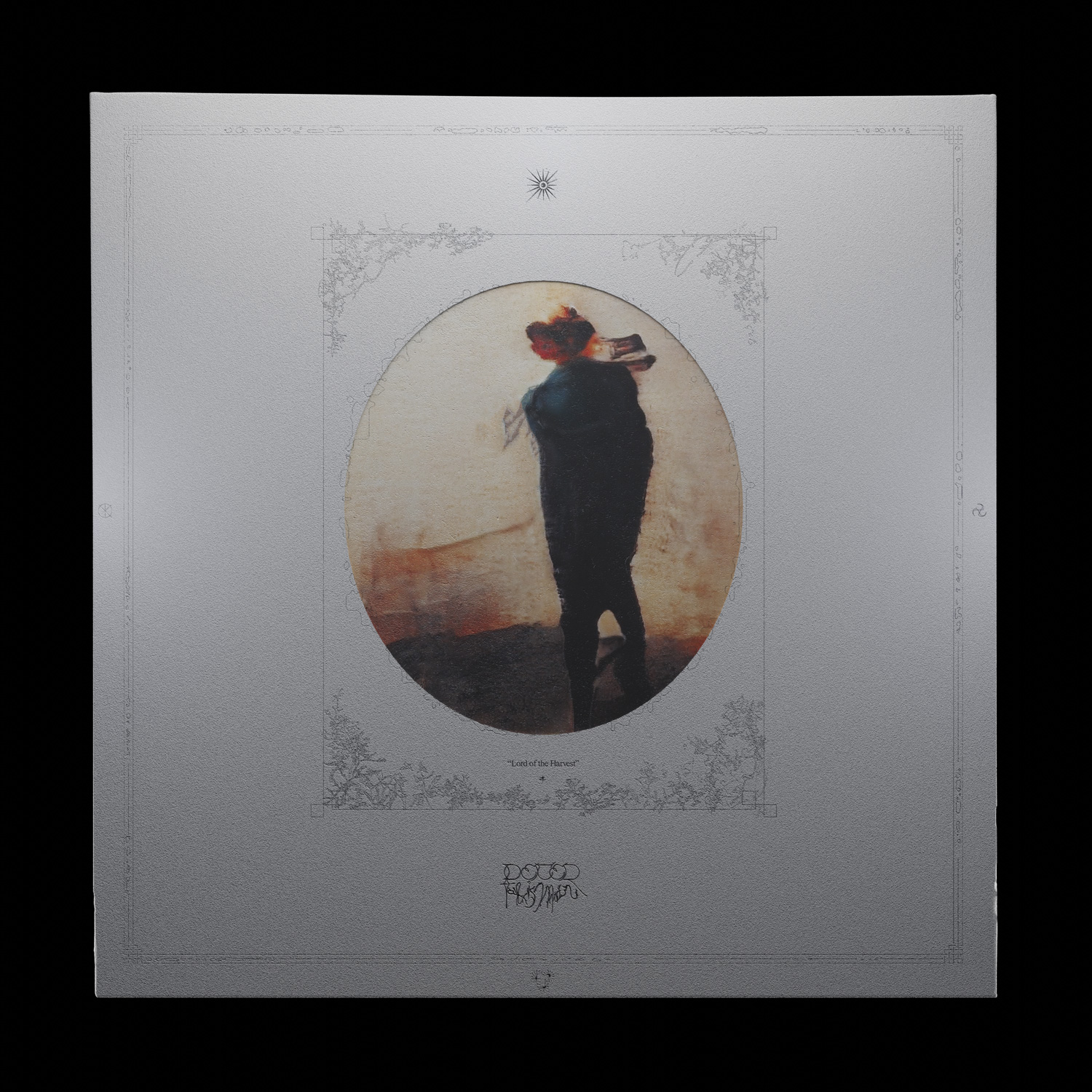
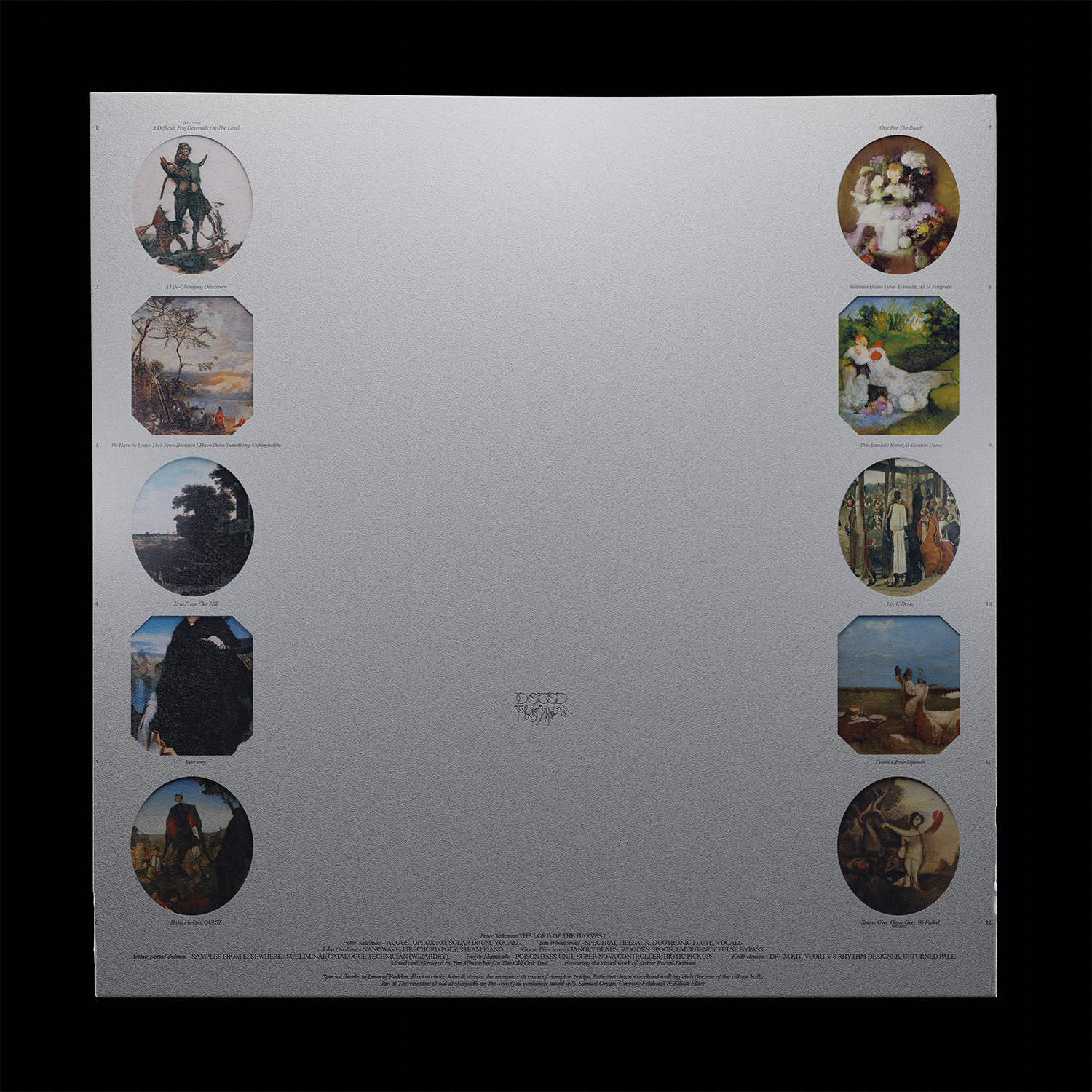
SS:You used Monarch by Jacob Wise, how did that come about? And the dithering, was that a nod to Return of the Obra Dinn?
BW:We just like Jacobs’ work and it felt consistent with the theming, traditional but also futuristic. The dithering referencing Obra Dinn, interesting, maybe subconsciously? There’s some foundation for it technically as well. The corn has to be single hair lines, to be efficient. But they’re also deliberately not anti-aliased, they looked bad anti-aliased. So the corn is a one-pixel crunchy aliased line, and that pixelation spreads out from there through the rest of the site’s aesthetic.
SS:I even felt a bit of Kentucky Route Zero’s horseshoe animation on click in how the Beacon of Barnstable feels, did you find game references leaked in?
BW:We both played Kentucky Route Zero on console, so we didn’t see that I don’t think. Populous: The Beginning, that was a big reference. A 3D world with little 2D sprite people. Peter Talisman’s done in a 3D engine, but you never see it in 3D until the end. The camera just does some rotating while everyone’s done. So that was a very cheap treat, it was always 3D, but now we’re going to show it to you.
SS:Was the ending something that you struggled with, to give it a crescendo?
BW:Well, we haven’t really spoken on the story yet actually. The ending comes from the second to last track, we sort of botched it into the last track. It’s called Dance of the Equinox. We said to ourselves, “Okay, yeah, everyone dances. That’s an ending. You’ve got those little men, and they all have a nice time.” But to get there we brought Callum on board. Roughly in the middle of the process, to just write. To enrich everything. To just put these bits of dialogue in there, and he really successfully managed to hang this weird thing together.
Callum Copley:Yeah. It was weird, because in terms of process ... From what I was given, I obviously had the album, and the names of the tracks had this kind of vibe that the project had been given from the artists, this kind of retro-futurist, neo-folk. Cyber pagan. A very weird mashup, which was interesting. And obviously, that comes through in the game and and all the weird stuff to do with the drones being donkeys and the hidden objects in the game that you can discover.
In terms of the story itself, we had the progression of tracks and the names of the tracks, and we discussed that the best moments for there to be dialogue and story would be each time you reach a new track. So, I kind of had to retroactively build a narrative that involved the characters from the small print on the back of the album – these made-up characters who played made-up instruments, trying to weave them into a story that kind of followed the arc of the album. And the thing is, the album itself wasn’t exactly written to be a narrative, so I had to retroactively do that. But that was an interesting challenge to be honest, I’d never done something like that. Normally, I’m the one doing the world building from scratch.
SS:So that first document and album art set out a sense of place that you could explore?
CC:Yeah, I singled out some phrases and pieces of the language and went from there. There were multiple mini narratives throughout the game that you switch between each time you get to a new song.
Another element that came through was the idea that you are kind of playing as Peter Talisman. You don’t actually control him, but I guess you are kind of embodying him in a way. At least in the narrative, you’re speaking from his perspective.
BW:In the dialogue, its clear that Peter Talisman and Arthur Portal-Dolmen are there. And when you cut through the corn to the first stone, that enables them to find it. Are they two of the peasants? Or are they somehow managing the peasants, or watching from the sidelines? In the end, we decided, “Who cares?” It’s really surprising how much stuff like that a player can accept.
SS:Theres even wordplay in the UI, “Have a Peasant”, “Construct a donkey”. How did that come about?
BW:Right. After you’ve made some number of peasants, the “hire a peasant” button starts changing its verb: “recruit a peasant”, “involve a peasant”, ”hatch a peasant” - I think I remember adding that for a little laugh probably at the end of a long day. It’s probably more confusing than funny on the whole, but I’m glad you appreciated it
SS:Who drew the geoglyphs and what was that process like?
BW:We worked with Armando D Cosmos. As with much game collaboration, we’re realising, it’s a process where your collaborator initially does the nicest piece of art for its own sake, and then we have to say: no, that creates these mechanical problems, please heavily compromise your wonderful work. In this case we didn’t want you to encounter the geoglyphs too often; we didn’t want big features in it that took too long to uncover; and we wanted the whole piece to be joined together so you could always follow what you had uncovered to find the rest. So it’s quite a sparse piece with these long lines tracing through it. Which is very cool for us but not exactly what Armando wanted to do.
Armando’s early sketches, the final result in-game and some of their other works:
SS:How much of a difference do you think you being outside of the games industry affected your process? Was there an element of almost outsider art at play? And what about the technical development aspect?
BW:Well yes, to start the performance aspect of the web isn’t amazing for things like this, single threaded and uses javascript = bad. There’s also a lack of premade engines that you find in standard games development, so you end up having to do some work on that front before being able to get going
JP:For web-based games the front door is still code for now, there’s no graphical user interface you can use to create yet. We might have had some sort of unique perspective we weren’t aware of coming from outside of games, like Burial making Untrue in Soundforge (see also: https://www.thewire.co.uk/in-writing/interviews/burial_unedited-transcript - ed.)
BW:I hadn’t thought of that. Another unique thing is that the web is a tool for laying out documents. User interface is very easy to do so we had the capacity to be expressive with the design of those elements.
SS:And did you run into any game development problems that didn’t come specifically from the medium?
BW:Corn optimisation and pathfinding were big learning curves. A good game developer would probably get it done in no time I’m sure but that took some time to get right. The peasant behaviour in general. We got a lot of feedback that the game might run a little slow when there were many peasants on screen, people having to snip a path for the peasants themselves to sort of optimise on the fly which was really interesting to learn.
SS:And what about progression? It feels quite finely tuned to me, what was that process like?
BW:Yes, that was tricky. To time it out based on each track length. We asked ourselves questions like, should the music loop until the next stone is found? Or do we let it end and force the progression with the silence left. There’s also the issue of reaching the next stone before the current track finishes which is almost like pressing fast-forward. Which felt unfair to the album sequencing.
A lot of the late stage iteration was tweaking those knobs of distance speed, distance, corn-cutting.
The actual hardest part, for something even this simple, was the game design. It was the most important work. Gameplay had to be tight so that the unusual aesthetic could be carried through. Something familiar for people to hold on to that were baffled by the way it all looked.
SS:What about QA, did you spend a lot of time testing?
BW:The main thing we learned, and another thing probably obvious to proper game developers, was to be careful about being an expert at your own game. Trying to put yourself in the shoes of someone who hasn’t made the whole thing from scratch. Getting that distance from the game, then finishing it and deciding if it was fun.
“I’ve got enough tabs as it is.” — Callum Copley
SS:How was the game received?
BW:I dropped it in the idle games subreddit. And due to having graphics, mainly, it was very different to everything else that was on there. They went kind of nuts for it, all our traffic came from there. There’s sort two things at once; the first, that the web is a unique distribution method that anyone can immediately start the game and get into it. That’s very, very important for a nobody development studio like us, compared to if we tried to put it on Steam and tell people about it, that would’ve been impossible. The second, the response from Reddit seemed to suggest that this was just much weirder than anything else that that audience had seen before.
JP:Which reminds me that the biggest complaint that came back was that video that Slugabed put at the end of himself.
CC:Oh my God, yeah. The success state.
BW:Yeah. When you get all the secret objects, there’s a little video that plays. It’s pretty disturbing.
CC:It’s a video of Slugabed filming, walking around his house in the dark, with a distorted voice, going, “Mm, thank you for playing the game. I’ve been watching you the whole time through your webcam.”
BW:I thought that was very funny when I saw it. Slugabed (½ of Peter Talisman) delivered that two days before the game came out. It’s really a nice piece to end on now, it’s hilarious. And a lot of people were just like, “Oh, yeah. Really cool game. Wow, what a journey, what a crazy thing. That video at the end. Jesus, I hate it.”
A lot of people sort of assume that the game is scary or find it creepy as well, which is another thing we didn’t expect. I think that’s mainly the AI people with wobbly faces and stuff.
JP:All in all, it was received well we think. A few people streamed it which was great. I remember one streamer needing to explain to her Japanese speaking friend what a peasant is, and explain a lot of the olde English dialogue to him, which is a cool outcome we never would have expected. Another great thing about web-based games.
CC:Free translation.
JP:Free translation. The correct way to play, the true experience.
Then there were also these guys who were streaming it and reading all the dialogue aloud, and one of them went into this falsetto Monty Python voice for a female character, and that character goes on speaking for much longer than he expected and he was really struggling to keep the voice up, which was hilarious
SS:Which leads me to the question, other than the examples we’ve already mentioned, is there anything that felt like Peter Talisman would exist alongside, in the canon of web-based games. Or do you feel like it’s quite singular, because you’re the only people who’s willing to put enough effort into something that ostensibly is very difficult to monetise?
BW:I mean, it harks back to Newgrounds in a lot of ways, really. The type of thing that I would’ve been looking at when I was at secondary school. Jay is Games, too, it actually got on Jay is Games, which I was proud of, because I used to look at that when I was not doing IT class.
I don’t know if we’re just less plugged into that now, but obviously, that used to be a huge thing. Flash, essentially, is what we’re talking about, then Flash went away. The technology has obviously caught up now, to the point that you can do similar things to what used to be possible in Flash.
SS: At the same time, it’s synchronised with things like Unity becoming more available to people. So instead of making a browser-based game and then sharing it on the web, you could build it as a game and sell it on itch.io or even Steam.
BW:Also, Flash as a sort of relatively user-friendly desktop application, inspired a high level of unseriousness. Looking back on it, there were Flash games that I dismissed internally because they were built in Flash, but now I understand that somebody set out to make a proper game and did. I think there would’ve been people in the Flash age doing things that are of the scope of Peter Talisman with the technology of the time. Just for the fun of it. Putting it on Newgrounds, and it doing well and that being satisfying for them.
“I just want to make someone cry.” — Joseph Pleass
SS:Is the idea to eventually transition to a more standard video game development process?
BW:I think so, from the point of view of monetization, yes. Also the web is amazing for distribution but isn’t the best technology for it either.
CC:We’ll want to challenge ourselves to do something bigger and more complex in scope each time. Speaking for myself, I would like to push what’s possible. To try something, even if it’s only incrementally more interesting. There’s a point where you have to break out of the browser, I would imagine.
JP:But also, it’s such a great niche to be a part of.
BW:Yeah sometimes I almost question why I’m thinking that way? Because obviously, it’s possible to monetize a web game, that’s obviously something you could do. Maybe it’s just about perception.
SS:Becoming “real” game developers. Even though you're making games now. I wonder will it all almost coalesce at some point and become a situation where there are some cloud-based streaming games, indie games that can run in the browser due to improved web technologies, and traditional games all available in tandem? I also pay for plenty of things now that I wouldn’t have before, we've figured out ways to monetize media that people thought of as free already.
BW:Yes, but there’s also perception. If I like a game that's on Steam, I expect to pay a certain amount there. Or on PlayStation, even more. If I see a web game that looks good and they ask for money, am I into that? Maybe not.
JP:I think you raise a good point, it’s contextual and perceptual. I think some of it is learned behaviour. Even making the game we're working on now, which is bigger in scale to Peter Talisman, and honestly, looks a lot like what you’d expect a sort of independent game released on the Switch to look like.
I think you expect to go on a computer and open up Steam and click a game, and it comes up full screen, you play it. But to go onto a web browser, type in the address and start playing a game, its odd behaviour, and I think that's the thing that would make me not want to do another web browser game. It's just this weird, learned behaviour about how you expect to receive media. You just don't expect to receive a full video game in a web browser.
CC:I’ve got enough tabs as it is.
SS:Also your perspective as web-developers-turned-game-developers probably recontextualizes things even more.
JP:I wonder if you come into the world as a game developer, are you expecting a project to get a certain amount of money back for your input, that maybe as web developers, we don’t have? What I’m saying is, there was never any idea of monetization in any of the work we’ve been doing anyway.
BW:Peter Talisman is an advert.
SS:Feels like experiences like this are either tech demos or exist because they’re funded by a corporation to make them look nice, relevant and approachable.
BW:Like Coastal World. It’s an advert for a bank, where you can stroll around little islands and talk to people about a bank account. It got so much attention. There's a developer write up of it that was very useful in a lot of ways for our game.
And tragically, this is one of the more sophisticated outings in this space. To walk around and talk to Bridget about compound interest or something.
JP:I really hope that got pitched because a CEO somewhere had their 11-year-old kid come into the office and say, “You should make a game,” and that was that.
SS:Let’s talk about your next game, from what I understand you’re right in the thick of development. What has it been like the second time around?
BW:It feels very different this time, because we’ve now finished something, so game development doesn’t feel like an experiment anymore. We were lucky enough to receive a starter grant from the Creative Industries Fund NL which has helped us to formalise our studio and develop our new game.
While we’re aiming for a similarly compact and casual experience, web-based experience again, we’ve definitely been more ambitious about every part of it, and while that’s been fun and educational and we’re happy with how things are going, it is taking a LOT longer and that means we feel more pressure to get it right.
The main difference in the process has been that Callum’s involved from the beginning and we’re working much more directly from a scenario and story he’s writing. We’re navigating what I’m sure is a normal game studio process of wrecking his ideas to make things work mechanically, and giving him back really weird mechanical things to justify narratively.
SS:You’ve asked Slugabed and Samuel Organ (Peter Talisman) to make the album for this new game too. Did it feel different, starting without a soundtrack to guide you?
BW:I guess it did, which is why we quite quickly made a playlist of music references as a way to establish tone for the game. I think that was a really important method for the three of us to communicate about how we want the game to feel at a very subjective level, when it's too early to pin anything down in images or text. Music's good like that.
That playlist became a reference for Samuel and Slugabed, and now that's become demo tracks which already sound great. Their input is absolutely key in finding the shape of what this is going to be.
SS:Let’s end on Soft Earth, what made you decide to start the studio, and what’s next?
BW:Mainly we just had a great time making Peter Talisman and the reception for it was really positive, so we're all hungry to do more.
CC:I want to continue to make games that feel unique and are fun for us to make (and for the player to play too, if we have to).
We all do commercial work for clients most of the time, and that's great too in general, but there's always an awareness that your work isn't the point, isn't the primary thing, the client's product is, and you're supporting that. So it feels exciting to apply the skills we've developed through that work onto our own thing, which is itself the thing and the point. Like a director breaking out from advertising into films, maybe.
Speaking of films, I read somewhere recently that if you take the age of the medium of games, from invention until today, and compare it to the development of film 100 years ago, we're now around the time of Citizen Kane. So that suggests that a lot is still going to change. It feels like a huge space to get into and experiment.
JP:I just want to make someone cry.
[ POSTSCRIPT ]
After I spoke with Soft Earth, I managed to track down Slugabed (½ of Peter Talisman) to ask him about their perspective on the whole process and what they thought of the end result.
SS:I've read the Lord of the Harvest manifesto, does world-building like this factor into your process often? What led to the creation of Peter Talisman and Arthur Portal-Dolmen?
Slugabed:I think we both enjoy the aspect of world-building, to varying degrees for different projects. Personally, I find creating a so-called “concept album” (for want of a better term) gives a lot of the satisfaction of telling a story, but without the need to be any good at storytelling. Being a musician, particularly working in instrumental and/or esoteric music, allows you to create as much or as little of a narrative as you see fit. For me, that is an aspect that makes it the perfect medium to express myself, as i can create a dreamlike world, but not feel the need to overly prescribe it to anyone else. The ambiguity that is created as a result of my laziness is an integral factor in the final world. It was fun creating this stuff together, and an early part of it was naming band members (Arthur Portal-Dolmen, Keith Demon, Gorse Panshawe etc etc) and as the themes developed, so too did the characters.
SS:How do you feel about the game and how it represents the album? Do you think adding an extra layer like this adds or detracts from the experience of the album itself?
Slugabed:The game has been a hugely beneficial addition to the music, deepening our confused and ambiguous lore around the album much further than we could have hoped to do on our own. The gameplay itself is totally complimentary to the experience of listening to an album, as it is just engaging enough but also meditative and slow. The stories and themes that the guys developed were really a pretty perfect representation of how me and Sam wanted to present the music. It felt almost serendipitous how well it turned out.
SS:What’s it like working in reverse for Soft Earth's next game? Making the album to suit the game rather than a game from an album? Are you finding the process of creating a soundtrack different in any way?
Slugabed:In one sense, it is a totally different experience this time around, as for the Peter Talisman game, the album was already totally finished when production of the game began, so from our end, it was all excitement and bouncing goofy ideas around and waiting patiently for a cool game to appear. This time we have to actually do some work! In many ways this experience is more fun, as it is really nice to work with a world somebody else has created and be given the license to deepen and adapt it in our own way. With both games, I feel the game gang and the music gang have a mutual trust which means whichever way round we create game/music/game (or vice versa), we are still given a lot of freedom to guide what the end experience will become, which is very nice.
Peter Talisman: Lord of the Harvest is available to purchase on bandcamp and the game can be played at petertalisman.quest. Sign up to the Kepler Interactive newsletter to be the first to hear about our next editorial feature.
